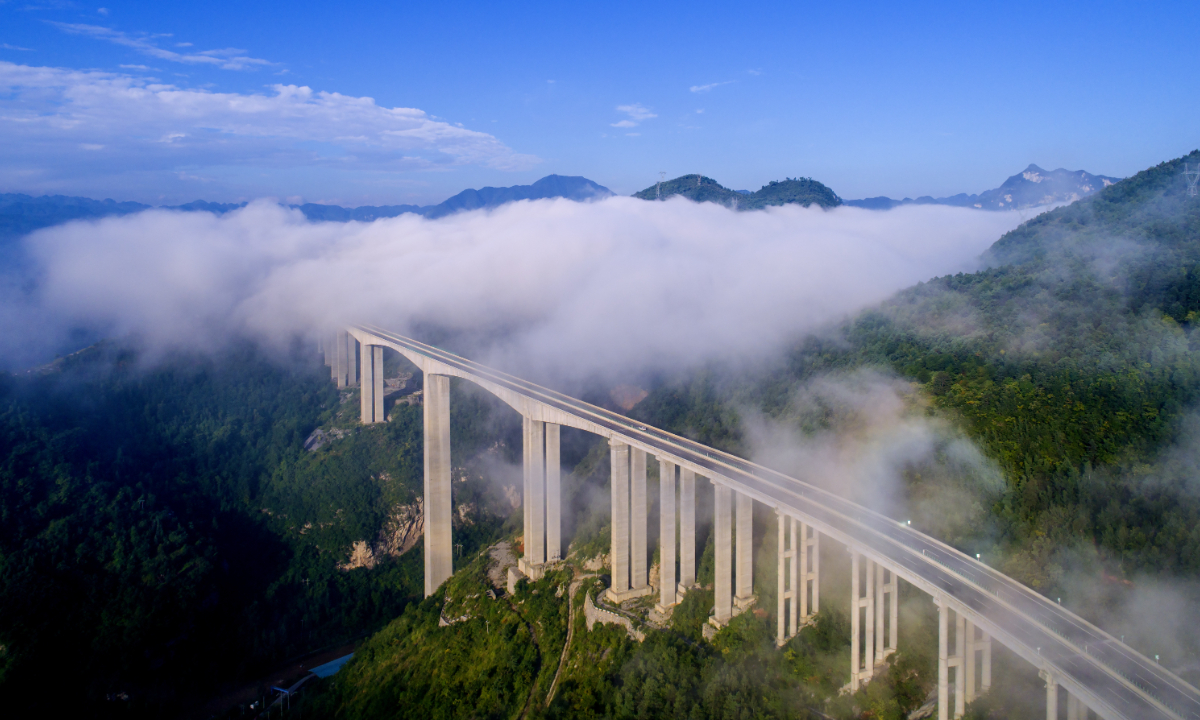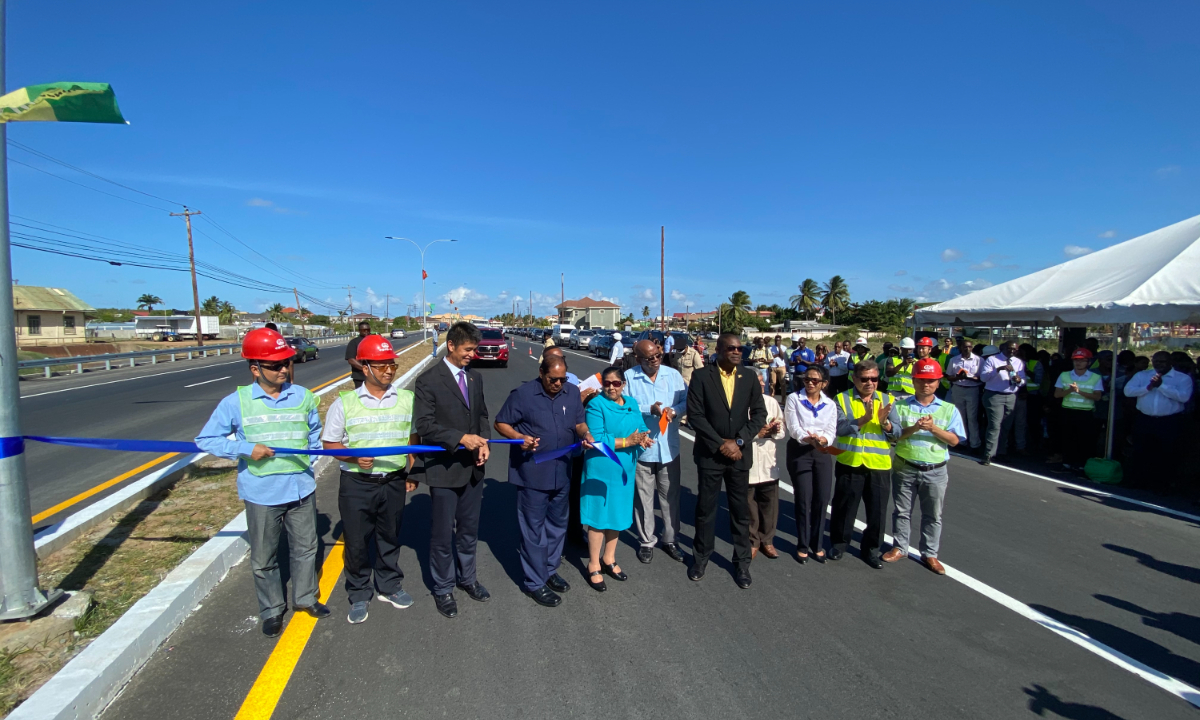In this series which tries to unpack the concept of the Chinese Dream through specific stories and anecdotes, the Global Times reporters talked to ordinary Chinese citizens – an aerospace engineer participating in the launch of China’s first space station, a grassroots official dedicated to rural revitalization, an environmental warrior combating desertification in the Gobi desert, an artist promoting traditional Chinese culture, as well as a worker at a Belt and Road Initiative (BRI) project overseas – to see how the Chinese Dream inspires the nation and the world.
This last installment of the series focuses on how the Chinese Dream has connected the world through technology and infrastructure.

Photo: IC
Allen, a 45-year-old mechanic who works at an auto repair shop east of Georgetown, Guyana’s capital, cheerfully zooms along the wide, unimpeded four-lane highway to make purchases for his burgeoning auto repair shop, getting to the city center in just 20 minutes. Five years ago, the same commute would have taken more than one hour owing to the previous 17 kilometers of muddy and congested narrow road. He did not anticipate just how much the renovated road would instantly transform the lives of thousands of commuters.
On this road, Allen’s dream of earning more money converged with the Chinese Dream of connecting the world via modern technology.
In 2017, the East Coast of Demerara (ECD) public road officially underwent widening and renovation under the China-Guyana cooperation with a concessional loan given by the Export-Import Bank of China.
The project saw the construction of a 7-kilometer four-lane road, with each lane being 3.6 meters wide, and renovation of a 10-kilometer two-lane road, along with sidewalks and other supporting structures.
Georgetown is less than one-thousandth the size of Guyana, but is home to nearly one-third of the country’s population. Easing traffic congestion between Guyana’s east coast and the capital city has been a long-awaited dream for Guyanese people.
The upgraded road can also be extended to the neighboring country of Suriname, benefiting more than 300,000 people along the route and driving the economic development of Guyana and Suriname.
“A large number of residents in the east coast area have to drive on this road into the capital city daily. The initial dual carriageway without lights, signals, or road signs was fraught with peril. The Guyanese government had a road upgrade plan for a long time, but it had been unable to realize it due to reasons such as lack of funds,” Gao Zeliang, general manager of China Railway First Group Guyana office, a Chinese company contracted for the project, told the Global Times.
“The long-awaited repaired road, which is about 20 years old, was badly damaged and potholed, especially during the rainy season. There are two large wet markets along the road, which would make it more crowded at market peak time and weekends. After the upgrade, the road transformed into a clean and tidy relief, while concrete drains replaced the once open roadside gutter, with green belts set in the middle of the road, which is safe and beautiful,” said Gao.
A Guyanese governmental official, who attended the reopening ceremony of the improved road in 2020, termed the road as the best in Guyana.
Even more noteworthy is that the improved road has reduced traffic accidents and boosted regional economic development, allowing local people to get on the rapid prosperity train.

Officials from China and Guyana attend the ribbon-cutting ceremony of the East Coast of Demerara (ECD) road reopening after renovation on February 27, 2020. Photo: Courtesy of Gao Zeliang
Sustainable development in future
Mike, 52, a former taxi driver in Georgetown, applied to join the Chinese contractor in 2017. With his great knowledge of local streets, Mike would drive and ferry materials for the project. After the road project was completed, Mike and some of his colleagues decided to stay in the Chinese company for more projects. High salaries from working for a Chinese company attracted Mike as he can earn nearly 9,000 yuan ($1,290) per month, and a triple salary over the holidays, well above the local average, and nearly double what he would earn as a taxi driver.
After working for the Chinese company for three years, Mike saw his wish of renovating his once dilapidated wooden house come true. Now, in its place stands a modern concrete house for his family.
In Mike’s eyes, Chinese companies offer better welfare packages than many local enterprises, and he can receive extra gifts and bonuses for holidays such as Christmas.
Gao said that the road improvement project has created nearly 300 local jobs. What’s more, the Chinese contractor has regularly organized comprehensive training sessions for local employees to acquire infrastructure expertise, laying a foundation for Guyana’s sustainable development dream.
“China has unreservedly imparted its technology and management expertise to us, bringing wonderful changes to our lives,” Paul Pressey, the head of a local community near the road, who takes the road every day to send his children to school in the capital city, told the Global Times.
“Every time I talk to residents along the road about the changes, they are full of praise. The road improvements have greatly facilitated our travel,” said Pressey.
In 2018, the Chinese and Guyanese governments signed an MOU on the Belt and Road Initiative (BRI), which injected new momentum into the practical cooperation between the two sides. The bilateral cooperation covers agriculture, energy, mining, transportation, and ICT, etc.
China’s BRI and Global Development Initiative are welcomed by Guyana and are “seen as an important vehicle for the further advancement of global cooperation, connectivity, and people-to-people exchanges,” Guyana’s Ambassador to China Anyin Choo said in July when commemorating the 50th anniversary of the establishment of diplomatic relations between China and Guyana.
Nigel Erskine, the Guyanese principal of the road upgrade project, said it was unprecedented in Guyana to see such a big transformation completed in as short a time as 28 months. Chinese quality and efficiency have won trust and gained a good reputation in Guyana, Gao told the Global Times.
“The ECD highway brings together the friendship, wisdom, and sweat of the people of China and Guyana. It is the interweaving of the dream of development of the two countries,” Gao said.
“To make Guyana develop rapidly is a dream shared in the hearts of Chinese builders and Guyanese people, while China is lighting up Guyanese people’s hopes with real technology.”
“A flower is more beautiful when it is put in a bundle or it blooms in large numbers in a vast area. It is really an honor to see the flowers of the Chinese Dream bloom in a harmonious and friendly way in other continents across the world,” said Gao.
(Global Times)




